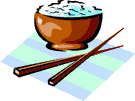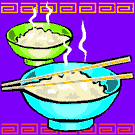
Brown rice is the wholegrain of unpolished rice. The outer shell, filled with nutrients, gives it the distinctive brown color. Polishing rice removes the germ and the yellowish-brown outer layers (which contain the bran).
White rice is rice with the nutritious outer hull removed by polishing, giving it the distinctive white color. There are still some nutrients (in particular starch), but most of the valuable nutrients have been removed. White rice is fluffier than brown rice.
See also rice milk.
- botanical information
- origin
- history
- nutritional information
- magick correspondences and uses
- ritual uses
- Goddesses and deities
- health care
- Chinese herbology
- external skin care
- cautions and contraindications
botanical information:
Botanical name: Oryza sativa or Oryza glaberrima
Common name: brown rice, rice, white rice
Use the botanical name when ordering seeds (bulbs, etc.) or when looking up information in the library. Common names vary by nation, culture, and region, and sometimes the same common name is applied to different plants.

Wild rice isn’t actually a rice, but is similar to brown rice in look, texture, taste, and nutrients.
origin:
Origin: deltas of the Ganges (India), Yangtze (China), Tigris and Euphrates (Sumeria), and Nile (Egypt) River valleys
history:
History: By 1000 B.C.E. the Chinese were distlling rice wine.
Rice is now grown on every continent other than Antarctica. In 2007, approximately 645 million tons of rice was growning 114 countires.
nutritional information:
Rice is a good source of protein.
Wholegrain rice is a source of iron.
See also: brown rice, wild rice, sweet rice.
See also Chinese herbalism below for Chinese gender and Chinese flavor.

More than 3-billion people in Asia use rice as a staple. Rice is an essnetial food in parts of Africa and the Caribbean.
magickal correspondences and uses:
Western element: (for rice milk) air
Magickal uses for rice milk: boost fertle energy
ritual uses:
Buddhist customs: In Japan, sticking chopsticks into a bowl of rice is considered a sign of the dead, based on Buddhist funeral beliefs. Similarly, passing food to another person from chopstick to chopstick is considered a sign of death.
deities associated with rice milk:
- Ukemochi (Shinto Goddess)
health care uses:
Health Notice: Attempting to be an amateur doctor is potentially dangerous to your health. This web page is not professional medical advice. Nothing on this website should be considered as a substitute or replacement for professional medical advice. Persons should seek the advice of qualified health providers. Self-medication should not be used as a substitute for professional medical care. Please confirm all self-medication with your doctor or health care professional. See the article on healing for recommended healers.
Chinese herbalism:
The Chinese viewed rice as the most neutral and balanced of all foods.
Chinese gender: neutral
Chinese flavor: sweet
Sweet rice is slightly warm and sweet.
external care:
 External skin care: Rice protein in Belli Life After Baby Eye Brightening Cream: “Lightens dark circles, reduces puffiness and fine lines. Physician-formulated, Vitamin K-enriched eye treatment keeps eyes looking refreshed and well rested by enhancing circulation, hydrating delicate skin, lightening dark circles, and minimizing the appearance of fine lines. With rice and soybean protein, aloe, olive oil, and green tea extract. Gently pat underneath eye area daily as needed.” Belli Life After Baby Eye Brightening Cream
External skin care: Rice protein in Belli Life After Baby Eye Brightening Cream: “Lightens dark circles, reduces puffiness and fine lines. Physician-formulated, Vitamin K-enriched eye treatment keeps eyes looking refreshed and well rested by enhancing circulation, hydrating delicate skin, lightening dark circles, and minimizing the appearance of fine lines. With rice and soybean protein, aloe, olive oil, and green tea extract. Gently pat underneath eye area daily as needed.” Belli Life After Baby Eye Brightening Cream
cautions and contraindications:
Cautions and contraindications: Rice is believed to be safe.
Do not eat white rice or brown rice raw.
See also: rice milk













